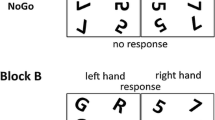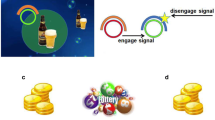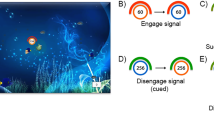Abstract
High-dosage alcohol intoxication (i.e., binge drinking in humans) is an increasingly prevalent problem. Despite the well-known long-term consequences, the acute effects of high-dosage alcohol intoxication on cognitive control processes have not been investigated with respect to neurophysiological changes in humans. We provide insights into the effects of high-dosage ethanol intoxication on action control functions in humans on the basis of neurophysiological (EEG) data. Action control processes were examined in a stop–change task. Based on a detailed analysis of behavioral and electrophysiological data, we demonstrate a specific modulation of action cascading processes. Opposed to commonly held views, high-dosage ethanol intoxication (0.9–1.13 ‰) exerts highly specific effects on cognitive subprocesses mediating action control. If action control processes are performed in succession, intoxicated and non-intoxicated participants perform equally well. However, action control processes become compromised during high-dosage ethanol intoxication, when different response options require processing resources in parallel. Under high-dose ethanol intoxication, subjects are not able to prioritize different response options. We could demonstrate that the effects were of high effect sizes (η 2 = 0.702) and rely more on response selection deficits than on deficits in attentional processing. The changes in response selection processes are mediated via the anterior cingulate cortex. The specificity of the observed effects may be due to a differential involvement of dopaminergic and GABAergic processes in action control and attentional selection processes.




Similar content being viewed by others
Notes
One limitation to this interpretation remains: According to Verbruggen et al. (2008), it is impossible to distinguish between the behavioral effects (RT slope values) of a nondeterministic serial processes and parallel processing based on the RT slope value (c.f. Verbruggen et al. 2008 for a detailed discussion on this issue).
The (Nogo)-N2 (occurring 200–300 ms after the inhibitory signal, see e.g. van Boxtel et al. 2001; Falkenstein et al. 1999) has frequently been analyzed with respect to inhibitory control processes. In the SC trials, a Nogo-N2 like component is evident in the SCD 300 condition (refer Fig. 4). However, in the SCD 0 condition, this component is not detectable due to the simultaneously occurring change processes. Since the (Nogo)-N2 is thus not quantifiable in all conditions, the (Nogo)-N2 was not included in the analyses.
We run an analysis where we included the factor “time” (first or second session with alcohol intoxication) as a between-subject factor in the ANOVA. There was no main effect “time” and no interaction effect with this factor in the behavioral and the neurophysiological data (all F < 1.1; p > .3). The results are therefore unbiased with respect to the testing point.
References
Angerer J, Gündel J (1996) Alcohols and Ketones [Biomonitoring Methods, 1996]. doi:10.1002/3527600418.bi6764e0005
Babor TF, Higgins-Biddle JC, Saunders JB, Monteiro MG (2001) The alcohol use disorders identification test guidelines for use in primary care, 2nd ed. WHO/MSD/MSB/01.6a
Bar-Gad I, Morris G, Bergman H (2003) Information processing, dimensionality reduction and reinforcement learning in the basal ganglia. Prog Neurobiol 71:439–473
Başar E, Schürmann M, Demiralp T, Başar-Eroglu C, Ademoglu A (2001) Event-related oscillations are ‘real brain responses’—wavelet analysis and new strategies. Int J Psychophysiol 39(2–3):91–127
Beste C, Dziobek I, Hielscher H, Willemssen R, Falkenstein M (2009) Effects of stimulus-response compatibility on inhibitory processes in Parkinson’s disease. Eur J Neurosci 29:855–860
Beste C, Domschke K, Falkenstein M, Konrad C (2010) Differential modulations of response control processes by 5-HT1A gene variation. Neuroimage 50(2):764–771
Beste C, Ness V, Falkenstein M, Saft C (2011) On the role of fronto-striatal neural synchronization processes for response inhibition—evidence from ERP phase-synchronization analyses in pre-manifest Huntington’s disease gene mutation carriers. Neuropsychologia 49(12):3484–3493
Beste C, Ness V, Lukas C, Hoffmann R, Stüwe S, Falkenstein M, Saft C (2012) Mechanisms mediating parallel action monitoring in fronto-striatal circuits. Neuroimage 62:137–146
Botvinick MM, Cohen JD, Carter CS (2004) Conflict monitoring and anterior cingulate cortex: an update. Trends Cogn Sci 8:539–546
Brisson B, Jolicoeur P (2007) Cross-modal multitasking processing deficits prior to the central bottleneck revealed by event-related potentials. Neuropsychologia 45:3038–3053
Cameron IG, Watanabe M, Pari G, Munoz DP (2010) Executive impairment in Parkinson’s disease: response automaticity and task switching. Neuropsychologia 48:1948–1957
Clapp P, Bhave SV, Hoffman P (2008) How adaptation of the brain to alcohol leads to dependence: a pharmacological perspective. Alcohol Res Health 31(4):310–339
Claus ED, Feldstein Ewing SW, Filbey FM, Hutchison KE (2013) Behavioral control in alcohol use disorders: relationships with severity. J Stud Alcohol Drugs 74(1):141–151
Crabbe J, Harris RA, Koob GF (2011) Preclinical studies of alcohol binge drinking. Ann NY Acad Sci 1216:24–40
Demiralp T, Ademoglu A, Comerchero M, Polich J (2001) Wavelet analysis of P3a and P3b. Brain Topogr 13(4):251–267
Dougherty DM, Marsh-Richard DM, Hatzis ES, Nouvion SO, Mathias CW (2008) A test of alcohol dose effects on multiple behavioral measures of impulsivity. Drug Alcohol Depend 96(1–2):111–120
Duncan J (2010) The multiple-demand (MD) system of the primate brain: mental programs for intelligent behaviour. Trends Cogn Sci 14:172–179
Faingold CL, N’Gouemo P, Riaz A (1998) Ethanol and neurotransmitter interactions—from molecular to integrative effects. Prog Neurobiol 55(5):509–535
Falkenstein M, Hohnsbein J, Hoormann J (1994a) Effects of choice complexity on different subcomponents of the late positive complex of the event-related potential. Electroencephalogr Clin Neurophysiol 92:148–160
Falkenstein M, Hohnsbein J, Hoormann J (1994b) Time pressure effect on late components of the event-related potential (ERP). J Psychophysiol 8:22–30
Falkenstein M, Hoormann J, Hohnsbein J (1999) ERP components in Go/Nogo tasks and their relation to inhibition. Acta Psychol (Amst) 101:267–291
Field M, Wiers RW, Christiansen P, Fillmore MT, Verster JC (2010) Acute alcohol effects on inhibitory control and implicit cognition: implications for loss of control over drinking. Alcohol Clin Exp Res 34(8):1346–1352
Fillmore MT, Van Selst M (2002) Constraints on information processing under alcohol in the context of response execution and response suppression. Exp Clin Psychopharmacol 10(4):417–424
Frank MJ, Doll BB, Oas-Terpstra J, Moreno F (2009) Prefrontal and striatal dopaminergic genes predict individual differences in exploration and exploitation. Nat Neurosci 12(8):1062–1068
Friedman RS, McCarthy DM, Bartholow BD, Hicks JA (2007) Interactive effects of alcohol outcome expectancies and alcohol cues on nonconsumptive behavior. Exp Clin Psychopharmacol 15(1):102–114
Fuchs M, Kastner J, Wagner M, Hawes S, Ebersole JS (2002) A standardized boundary element method volume conductor model. Clin Neurophysiol 113:702–712
Goldman-Rakic PS, Muly EC III, Williams GV (2000) D(1) receptors in prefrontal cells and circuits. Brain Res Brain Res Rev 31(2–3):295–301
Heinz AJ, Beck A, Meyer-Lindenberg A, Sterzer P, Heinz A (2011) Cognitive and neurobiological mechanisms of alcohol-related aggression. Nat Rev Neurosci 12(7):400–413
Humphries MD, Stewart RD, Gurney KN (2006) A physiological plausible model of action selection and oscillatory activity in the basal ganglia. J Neurosci 26:12921–12942
Jernigan DH (2001) Global status report: alcohol and young people. WHO/MSD/MSB/01.1
Kelm MK, Criswell HE, Breese GR (2011) Ethanol-enhanced GABA release: a focus on G protein-coupled receptors. Brain Res Rev 65(2):113–123
Kumar S, Porcu P, Werner DF, Matthews DB, Diaz-Granados JL, Helfand RS, Morrow AL (2009) The role of GABA(A) receptors in the acute and chronic effects of ethanol: a decade of progress. Psychopharmacology 205(4):529–564
Leblois A, Boraud T, Meissner W, Bergman H, Hansel D (2006) Competition between feedback loops underlies normal and pathological dynamics in the basal ganglia. J Neurosci 26(13):3567–3583
Logan GD, Cowan WB (1984) On the ability to inhibit thought and action: a theory of an act of control. Psychol Rev 91:295–327
Marco-Pallarés J, Grau C, Ruffini G (2005) Combined ICA-LORETA analysis of mismatch negativity. Neuroimage 25(2):471–477
Matsuzaka Y, Akiyama T, Tanji J, Mushiake H (2012) Neuronal activity in the primate dorsomedial prefrontal cortex contributes to strategic selection of response tactics. Proc Natl Acad Sci USA 109:4633–4638
Mazziotta J, Toga A, Evans A, Fox P, Lancaster J, Zilles K, Woods R, Paus T, Simpson G, Pike B et al (2001) A probabilistic atlas and reference system for the human brain: international consortium for brain mapping (ICBM). Philos Trans R Soc Lond B Biol Sci 356:1293–1322
Melis M, Diana M, Enrico P, Marinelli M, Brodie MS (2009) Ethanol and acetaldehyde action on central dopamine systems: mechanisms, modulation and relationship to stress. Alcohol 43(7):531–539
Miller J, Ulrich R, Rolke B (2009) On the optimality of serial and parallel processing in the psychological refractory period paradigm: effects of the distribution of stimulus onset asynchronies. Cogn Psychol 58:273–310
Montgomery C, Fisk JE, Murphy PN, Ryland I, Hilton J (2012) The effects of heavy social drinking on executive function: a systematic review and meta-analytic study of existing literature and new empirical findings. Hum Psychopharmacol Clin Exp 27:187–199
Mückschel M, Stock AK, Beste C (2013) Psychophysiological mechanisms of interindividual differences in goal activation modes during action cascading. Cereb Cortex. doi:10.1093/cercor/bht066
Oberauer K, Kliegl R (2004) Simultaneous cognitive operations in working memory after dual-task practice. J Exp Psychol Hum Percep Perform 30:689–707
Oddy BW, Barry RJ (2009) The relationship of N2 and P3 to inhibitory processing of social drinkers in a Go/NoGo task. Int J Psychophysiol 72(3):323–330
Oldfield RC (1971) The assessment and analysis of handedness: the Edinburgh inventory. Neuropsychologia 9:97–113
Pascual-Marqui RD (2002) Standardized low-resolution brain electromagnetic tomography (sLORETA): technical details. Methods Find Exp Clin Pharmacol 24:5–12
Pascual-Marqui RD, Esslen M, Kochi K, Lehmann D (2002) Functional imaging with low-resolution brain electromagnetic tomography (LORETA): a review. Methods Find Exp Clin Pharmacol 24(Suppl C):91–95
Plenz D (2003) When inhibition goes incognito: feedback interaction between spiny projection neurons in striatal function. Trends Neurosci 26:436–443
Polich J (2007) Updating P300: an integrative theory of P3a and P3b. Clin Neurophysiol 118:2128–2148
Ravizza SM, Goudreau J, Delgado MR, Ruiz S (2012) Executive function in Parkinson’s disease: contributions of the dorsal frontostriatal pathways to action and motivation. Cogn Affect Behav Neurosci 12:193–206
Read JP, Curtin JJ (2007) Contextual influences on alcohol expectancy processes. J Stud Alcohol Drugs 68(5):759–770
Redgrave P, Prescott TJ, Gurney K (1999) The basal ganglia: a vertebrate solution to the selection problem? Neuroscience 89:1009–1023
Rice OV, Patrick J, Schonhar CD, Ning H, Ashby CR Jr (2012) The effects of the preferential dopamine D(3) receptor antagonist S33138 on ethanol binge drinking in C57BL/6J mice. Synapse 66(11):975–978
Roach BJ, Mathalon DH (2008) Event-related EEG time-frequency analysis: an overview of measures and an analysis of early gamma band phase locking in schizophrenia. Schizophr Bull 34(5):907–926
Roberto M, Siggins GR (2006) Nociceptin/orphanin FQ presynaptically decreases GABAergic transmission and blocks the ethanol-induced increase of GABA release in central amygdala. Proc Natl Acad Sci USA 103(25):9715–9720
Sarter M, Gehring WJ, Kozak R (2006) More attention must be paid: the neurobiology of attentional effort. Brain Res Rev 51(2):145–160
Saunders B, Farag N, Vincent AS, Collins FL Jr, Sorocco KH, Lovallo WR (2008) Impulsive errors on a Go-NoGo reaction time task: disinhibitory traits in relation to a family history of alcoholism. Alcohol Clin Exp Res 32(5):888–894
Schweizer TA, Jolicoeur P, Vogel-Sprott M, Dixon MJ (2004) Fast, but error-prone, responses during acute alcohol intoxication: effects of stimulus-response mapping complexity. Alcohol Clin Exp Res 28(4):643–649
Seamans JK, Yang CR (2004) The principal features and mechanisms of dopamine modulation in the prefrontal cortex. Prog Neurobiol 74(1):1–58
Sekihara K, Sahani M, Nagarajan SS (2005) Localization bias and spatial resolution of adaptive and non-adaptive spatial filters for MEG source reconstruction. Neuroimage 25:1056–1067
Siggins GR, Roberto M, Nie Z (2005) The tipsy terminal: presynaptic effects of ethanol. Pharmacol Ther 107(1):80–98
Sigman M, Dehaene S (2008) Brain mechanisms of serial and parallel processing during dual-task performance. J Neurosci 28:7585–7598
Sinforiani E, Zucchella C, Pasotti C, Casoni F, Bini P, Costa A (2011) The effects of alcohol on cognition in the elderly: from protection to neurodegeneration. Funct Neurol 26(2):103–106
Sommer W, Leuthold H, Schubert T (2001) Multiple bottlenecks in information processing? An electrophyiso-logical examination. Psychon Bull Rev 8:81–88
Stock AK, Wascher E, Beste C (2013) Differential effects of motor efference copies and proprioceptive information on response evaluation processes. PLoS One 8(4):e62335
Tallon-Baudry C, Bertrand O, Delpuech C, Permier J (1997) Oscillatory gamma-band (30–70 Hz) activity induced by a visual search task in humans. J Neurosci 17:722–734
Tateno T, Robinson HP (2011) The mechanism of ethanol action on midbrain dopaminergic neuron firing: a dynamic-clamp study of the role of I(h) and GABAergic synaptic integration. J Neurophysiol 106(4):1901–1922
Turchi J, Sarter M (2001) Bidirectional modulation of basal forebrain N-methyl-D-aspartate receptor function differentially affects visual attention but not visual discrimination performance. Neuroscience 104(2):407–417
Urban NB, Kegeles LS, Slifstein M, Xu X, Martinez D, Sakr E, Castillo F, Moadel T, O’Malley SS, Krystal JH, Abi-Dargham A (2010) Sex differences in striatal dopamine release in young adults after oral alcohol challenge: a positron emission tomography imaging study with [(11)C]Raclopride. Biol Psychiatry 68(8):689–696
van Boxtel GJ, van der Molen MW, Jennings JR, Brunia CH (2001) A psychophysiological analysis of inhibitory control in the stopchange paradigm. Biol Psychol 58:229–262
van Holst RJ, Schilt T (2011) Drug-related decrease in neuropsychological functions of abstinent drug users. Curr Drug Abuse Rev 4(1):42–56
Verbruggen F, Schneider DW, Logan GD (2008) How to stop and change a response: the role of goal activation in multitasking. J Exp Psychol Hum Percept Perform 34:1212–1228
Verleger R (1988) The true P3 is hard to see: some comments on Kok’s (1986) paper on degraded stimuli. Biol Psychol 27(1):45–50
Verleger R, Jaskowski P, Wascher E (2005) Evidence for an integrative role of P3b in linking reaction to perception. J Psychophysiol 19:165–181
Vitacco D, Brandeis D, Pascual-Marqui R, Martin E (2002) Correspondence of event-related potential tomography and functional magnetic resonance imaging during language processing. Hum Brain Mapp 17(1):4–12
Watson PE, Watson ID, Batt RD (1980) Total body water volumes for adult males and females estimated from simple anthropometric measurements. Am J Clin Nutr 33(1):27–39
Welch KA (2011) Neurological complications of alcohol and misuse of drugs. Pract Neurol 11:206–219
Widmark EMP (1932) Die theoretischen Grundlagen und die praktische Verwendbarkeit der gerichtlich-medizinischen Alkoholbestimmung. Urban und Schwarzenberg, Berlin
Willemssen R, Falkenstein M, Schwarz M, Müller T, Beste C (2011) Effects of aging, Parkinson’s disease, and dopaminergic medication on response selection and control. Neurobiol Aging 32:327–335
Wiu C, Liu Y (2008) Queing network modeling of the psychological refractory period (PRP). Psychol Rev 115:913–954
Yordanova J, Kolev V (1998) Event-related alpha oscillations are functionally associated with P300 during information processing. NeuroReport 9(14):3159–3164
Yordanova J, Falkenstein M, Hohnsbein J, Kolev V (2004) Parallel systems of error processing in the brain. Neuroimage 22(2):590–602
Acknowledgments
This research was supported by a Grant from the Deutsche Forschungsgemeinschaft (DFG) BE4045/10-1. For the duration of data collection, the breathalyzer “Alcotest 300” was provided by Dräger Safety AG & Co. KGaA.
Author information
Authors and Affiliations
Corresponding author
Electronic supplementary material
Below is the link to the electronic supplementary material.
Rights and permissions
About this article
Cite this article
Stock, AK., Blaszkewicz, M. & Beste, C. Effects of binge drinking on action cascading processes: an EEG study. Arch Toxicol 88, 475–488 (2014). https://doi.org/10.1007/s00204-013-1109-2
Received:
Accepted:
Published:
Issue Date:
DOI: https://doi.org/10.1007/s00204-013-1109-2




